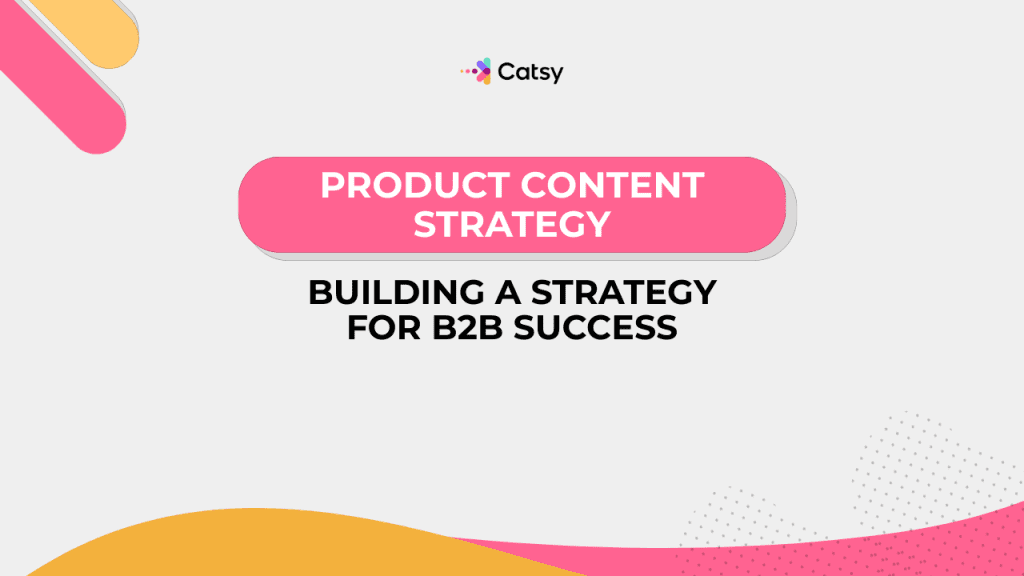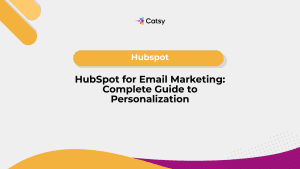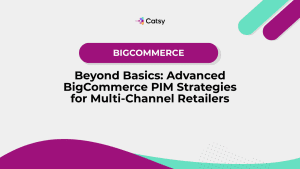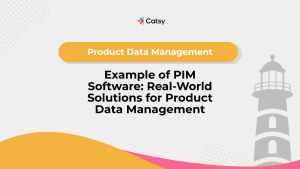Building a Product Content Strategy for B2B Success
Your B2B buyers expect the same personalized, seamless transactions as your B2C consumers!
Unfortunately, many B2B brands still fall short of delivering compelling content that converts.
That’s why you need a comprehensive B2B product content strategy.
Whether you’re a manufacturer, distributor, or enterprise seller, your content matters. It’s not just about spec sheets and item descriptions. Instead, it’s about creating engaging, scalable information that converts sales.

Why Product Content Strategy Matters in B2B E-commerce
Let’s start with a simple fact: In B2B operations, your product information is your strongest salesperson.
B2B buyers are a little different than B2C buyers in that the former shops in teams. They require technical validation, and they have much more complex purchasing cycles. The accuracy and completeness of your product content is essential to the B2B sales cycle.
According to Gartner, 83 percent of a B2B buyer’s journey is completed independently. Digital content guides every stage from shortlist to procurement.
You need a solid B2B e-commerce strategy to:
- Reduce friction in the buyer journey
- Improve your product discoverability across digital channels
- Build trust through transparency and authority
- Accelerate time-to-purchase with enriched product data
- Supply channel partners with accurate, scalable content
If your content isn’t doing the work, the competition’s content will.
In this Article
Core Challenges in B2B Product Content Management
As with any new system, you may face challenges with product content along the way.
❌ Complex Products
Many B2B products are “oddly specific” and must target a particular group of businesses. Use-case scenarios, detailed documentation, and contextual storytelling will be your friends.
❌ Multiple Stakeholders
Your B2B content must appeal to technical buyers, financial decision-makers, and end users… a diverse set of roles, with very different priorities!
❌ Channel Fragmentation
Your product data will be syndicated to websites, dealer portals, and sales tools that each have their own unique set of formatting requirements.
❌ Lack of Content Governance
If you have no centralized system, you’ll rely on chaotic spreadsheets, local files, and email threads. This results in incomplete, outdated, or inconsistent content.
The Pillars of a Successful B2B Product Content Strategy
To overcome these challenges and drive growth, your product content strategy should rest on these five key pillars:
Obviously, you want to overcome these challenges. To do this, your product content should rest on five pillars:
1. 🎯 Audience-Centric Product Storytelling
B2B buyers don’t just want specs – they want context. Good content tells a story that resounds with your buyer – their challenges, their goals, and their intended use of your product.
Tactics:
- Develop buyer personas to guide the tone and depth of your content
- Create content for different stages… the three phases are awareness, consideration, and decision
- Highlight your product’s benefits, outcomes, and real-world applications. Don’t rely on its features, but instead explain how those features benefit your consumer
Example: Instead of “Stainless steel valve, 2-inch diameter,” say “Engineered for high-pressure fluid control in industrial piping systems—resistant to corrosion, compliant with ASME standards.”
Make Catsy DAM and PIM Software an Extension of Your Team
Book a Free Demo2. 🧱 Structured Product Data & Attribute Management
Product data that’s accurate and consistent across channels will drive discoverability and conversion. Size, material, certifications, and tech specs should be consistently standardized across each of your channels.
Tactics:
- Use a Product Information Management (PIM) system like Catsy to keep your data centralized
- Standardize attributes by category
- Build templates for products in similar families
- Track completeness and accuracy of your information
Why It Matters: Structured data is imperative to the success of your SEO, filters, and faceted navigation. This is particularly true for distributor sites and within marketplaces.
3. 🌍 Omnichannel Content Syndication
If there’s one thing a B2B consumer is known for, it’s shopping around! Your content should be syndicated uniformly across each platform you utilize. This can include catalogs, marketplaces, and CRM systems.
Tactics:
- Automate the mapping of your content to channel-specific formats (like Amazon, Grainger, and Shopify)
- Tailor your product content based on region, audience, and channel requirements
- Ensure that your images, spec sheets, and translations are included in the syndication feed
With Catsy: You can syndicate rich product content to virtually anywhere from a central platform, leading to a reduction in manual errors.
4. 📊 Content Performance Analytics
It should come as no surprise that your product content strategy should be driven by real data. This will require oversight on your part.
Tactics:
- Ensure that your content is complete and ready to upload to channels
- Monitor your product page performance with respect to views, bounce rates, and conversions
- Use SKU-level analytics to identify gaps and missed or scalable opportunities
Example: A high-margin product with low visibility should be prioritized for optimization. Check for missing attributes, outdated PDFs, and other errors.
5. 🔄 Continuous Content Governance and Collaboration
SKUs evolve, markets change, and consumers’ wants shift. That means your content is never complete. Be sure to keep your data agile.
Tactics:
- Assign ownership of your data to departments within your company. Products, marketing, compliance, and sales are examples
- Set validation rules and approval workflows
- Track changes over time, and exercise version control
With a robust PIM, you ensure that everyone from marketing to compliance has the same true, clean data. This reduces silos and errors.
Building Your B2B Product Content Strategy: A Step-by-Step Guide
It’s time to put theory to action. Use the following rad map to build a high-impact, scalable content strategy:
Step 1: Audit Your Existing Product Content
- Where is your content stored today? (Spreadsheets? Shared drives?)
- How complete is your data? (Are there key attributes missing?)
- Is your product info consistent across channels?
- Which SKUs perform best… and why?
Take advantage of Catsy’s completeness scoring to benchmark the health of your existing product data.
Step 2: Define Buyer Personas and Journey Stages
It’s essential that you tailor your content to the buyer roles and journey stages that are most relevant to your business.
Stage Buyer Need Content Type
Awareness Understand product category Educational blogs, comparisons
Consideration Evaluate solutions Tech specs, videos, reviews
Decision Justify purchase internally ROI calculators, case studies
Step 3: Standardize Your Product Taxonomy
A well-structured taxonomy enables intuitive navigation and more effective merchandising. Consider:
- Defining categories and subcategories
- Creating reusable attribute sets
- Establishing naming conventions and metadata tags
- Building hierarchies for variants and bundles
Step 4: Centralize Product Data & Assets in a PIM
Are you still chasing your content across systems? You can use a PIM to:
- Import product data from ERP or spreadsheets
- Manage enriched data like images, PDFs, and videos
- Ensure version control and data accuracy
- Create tailored exports unique to each sales channel
Catsy provides a single source of truth for all your product and media content.
Step 5: Optimize Content for Each Channel
Each platform has its own content rules. Avoid one-size-fits-all listings. A few examples follow:
- Amazon requires bullet points and backend keywords
- Distributor portals may need EDI or XML feeds
- Direct-to-consumer sites benefit from lifestyle images and customer reviews
- Print catalogs require high-resolution layouts
Catsy makes it easy to automate formatting and subsequently distribute approved content to each channel you utilize.
Step 6: Track, Analyze, and Iterate
Use analytics to guide continuous improvement:
- Which product pages convert best?
- Where is content missing or underperforming?
- How are partners using your assets?
With actionable insights, you can fine-tune your product marketing strategy for better ROI.
Real-World Example: B2B Brand Transformation
Company: Industrial Tools Manufacturer
Challenge: Product specs lived in spreadsheets; images and PDFs were scattered. Channel partners often listed products with missing or outdated data.
Solution: Deployed Catsy PIM to centralize product content, standardize attributes, and automate syndication to their website, Amazon, and distributor portals.
Result:
- 50% faster product launches
- 80% reduction in content-related partner support tickets
- 3x increase in content compliance across all resellers
How Catsy Powers Your B2B Product Content Strategy
Catsy is purpose-built to support product content strategies for B2B organizations, combining PIM + DAM into a single, cloud-based platform.
With Catsy, you can:
- Centralize and enrich product data
- Manage digital assets and product media
- Automate content syndication to ecommerce platforms and marketplaces
- Customize content per channel, market, and partner
- Improve data governance and cross-team collaboration
Whether you’re managing 500 or 50,000 SKUs, Catsy helps you deliver a consistent, engaging, and optimized product experience at scale.
Final Thoughts: Content Is the New B2B Differentiator
In a crowded and competitive ecommerce landscape, product content is your differentiator. It’s what helps your brand cut through the noise, engage multiple stakeholders, and drive conversions—before a rep ever picks up the phone.
A smart, scalable B2B product content strategy:
- Aligns with your buyers’ needs
- Empowers partners with ready-to-use content
- Scales efficiently across SKUs and channels
- Drives visibility, trust, and revenue
With a platform like Catsy, you gain the control, agility, and automation needed to manage content as a strategic asset.
Want to build a high-performance B2B content engine?
👉 Request a free demo with Catsy and take the first step toward product content excellence.
Want more tips, tutorials, and insights on product content and e-commerce operations?
Stay connected. We post regularly to help brands like yours scale smarter.
Are You Ready To streamline your product content management?

Frequently Asked Questions
They include technical specifications, product descriptions, pricing, categorization data, product codes, product relationships (kits, accessories, etc.), regulatory/compliance data, product marketing content, rich media assets like images, videos, and 3D models, product documentation like manuals, and digital product renditions for e-commerce. Having a single source of truth for all this data prevents issues when distributing it to partners.
Inaccurate or incomplete product data flowing to distributors frequently leads to negative customer experiences in a few key ways: orders getting fulfilled with the wrong products, delays on orders, components missing from product bundles, sales staff’s inability to correctly market features, and customer returns and refunds due to products not matching expectations set by the product data. Customers get frustrated when their orders don’t match what was represented.
Industrial products are inherently complex, and the number of technical attributes that need to be accurately detailed is exponentially greater. There are complex specifications, product configurations, compatibility data, industrial certifications, product documentation, and more to account for. Any misstep in data accuracy could violate safety regulations or cause products to be unusable for their intended purposes. The room for error is far less.
Complete and accurate product data is essential for distributors to forecast demand correctly and set stocking levels to avoid stockouts or overstocks. They rely on data like product descriptions, pricing, product bundling details, and other marketing data to gauge customer demand. If crucial data elements are missing or wrong, it can completely throw off their sales projections and inventory planning. This leads to carrying costs or lost sales from not having the right products available.
A PIM centralizes and validates the core product details like technical specifications, descriptions, categories, etc. DAM software does the same for product-related media like photos, videos, documents, etc. When integrated, users can quickly map assets to corresponding product details in PIM to create enriched product experiences. This high-quality product data can be distributed to sales and marketing channels like distributor portals. The tight integration ensures consistent, high-quality product data and assets.
Subscribe For More Content
Sign up for monthly tips on how to drive revenue with product content.




